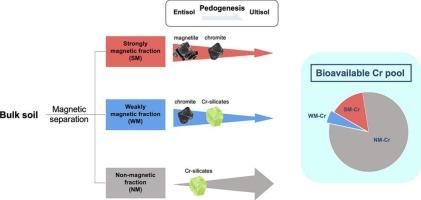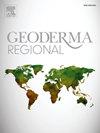磁性尖晶石如何促进台湾蛇纹岩土壤中地质铬的生物利用率
IF 3.1
2区 农林科学
Q2 SOIL SCIENCE
引用次数: 0
摘要
蛇纹石土壤富含地质铬(Cr),通常与尖晶石矿物有关。这些矿物具有很强的抗风化能力,这引起了人们对蛇纹岩土壤中铬生物利用率的关注。本研究从台湾东部的两个基质(Entisol 和 Ultisol)中采集了土壤层样本,并采用两步磁分离法将块状土壤分为强磁性(SM)、弱磁性(WM)和非磁性(NM)馏分。研究了大块土壤的基本特征。为了确定这些馏分的矿物学和地球化学特征,并确定它们对蛇纹石土壤中生物可利用铬的定量贡献,我们采用了各种光谱技术,如 X 射线衍射、电子探针显微分析、X 射线光电子能谱和 X 射线吸收光谱,以及振动样品磁力测定法,分析了它们的矿物组成、磁性、元素组成和化合价。结果表明,在 SM 和 WM 部分中,主要的含铬矿物是磁铁矿和铬铁矿,在 NM 部分中,蛇纹石和绿泥石等层状硅酸盐也有少量出现。总铬含量按以下顺序减少:SM;WM;NM。SM部分的重量比例最低,而这一比例在Ultisol中低于Entisol。这一观察结果表明,铬尖晶石的风化与破碎矿物颗粒中大量的 Al、Ca、Mn 和 Ni 阳离子取代铁和铬、以及磁铁矿中铁(III)和铬(VI)浓度的增加有关。主要由磁铁矿和铬铁矿组成的 SM 部分在 0.1 M HCl 的萃取下显示出最高的生物可利用铬浓度。然而,由于 NM 部分的重量比例高于其他部分,并且在成土过程中有所增加,因此含铬层硅酸盐是块状土壤中生物可利用铬的最大潜在来源。本文章由计算机程序翻译,如有差异,请以英文原文为准。

How magnetism-based fractional spinels contribute to the bioavailability of geogenic chromium in serpentine soils of Taiwan
Serpentine soils are highly rich in geogenic chromium (Cr), typically associated with spinel minerals. The high resistance of these minerals to weathering has raised concerns regarding their contribution to Cr bioavailability in serpentine soils. This study collected soil horizon samples from two pedons (Entisol and Ultisol) in eastern Taiwan and applied a two-step magnetic separation method to divide the bulk soils into strongly magnetic (SM), weakly magnetic (WM), and nonmagnetic (NM) fractions. The basic characteristics of the bulk soils were examined. To characterize the mineralogy and geochemistry of the fractions and determine their quantitative contribution of bioavailable Cr in serpentine soils, we analyzed their mineral composition, magnetic properties, and elemental composition and valence by using various spectrometric techniques, such as X-ray diffraction, electron probe microanalysis, X-ray photoelectron spectroscopy, and X-ray absorption spectroscopy, as well as vibrating sample magnetometry. The results indicated the main Cr-bearing minerals were magnetite and chromite in the SM and WM fractions, with minor occurrences in layer silicates, such as serpentine and chlorite, in the NM fraction. The total Cr content decreased in the following order: SM > WM > NM. The SM fraction had the lowest weight proportion, and this proportion was lower for the Ultisol than the Entisol. This observation indicated that the weathering of Cr spinels is associated with the substantial cation substitution of Al, Ca, Mn, and Ni for Fe and Cr in broken mineral grains and increases in the Fe(III) and Cr(VI) concentrations in magnetite. The SM fraction, mainly consists of magnetite and chromite, exhibited the highest concentration of bioavailable Cr extracted by 0.1 M HCl. However, the Cr-bearing layer silicates represented the largest potential pool of bioavailable Cr in the bulk soils because the weight proportion of the NM fraction was higher than those of the other fractions and increased during pedogenesis.
求助全文
通过发布文献求助,成功后即可免费获取论文全文。
去求助
来源期刊

Geoderma Regional
Agricultural and Biological Sciences-Soil Science
CiteScore
6.10
自引率
7.30%
发文量
122
审稿时长
76 days
期刊介绍:
Global issues require studies and solutions on national and regional levels. Geoderma Regional focuses on studies that increase understanding and advance our scientific knowledge of soils in all regions of the world. The journal embraces every aspect of soil science and welcomes reviews of regional progress.
 求助内容:
求助内容: 应助结果提醒方式:
应助结果提醒方式:


